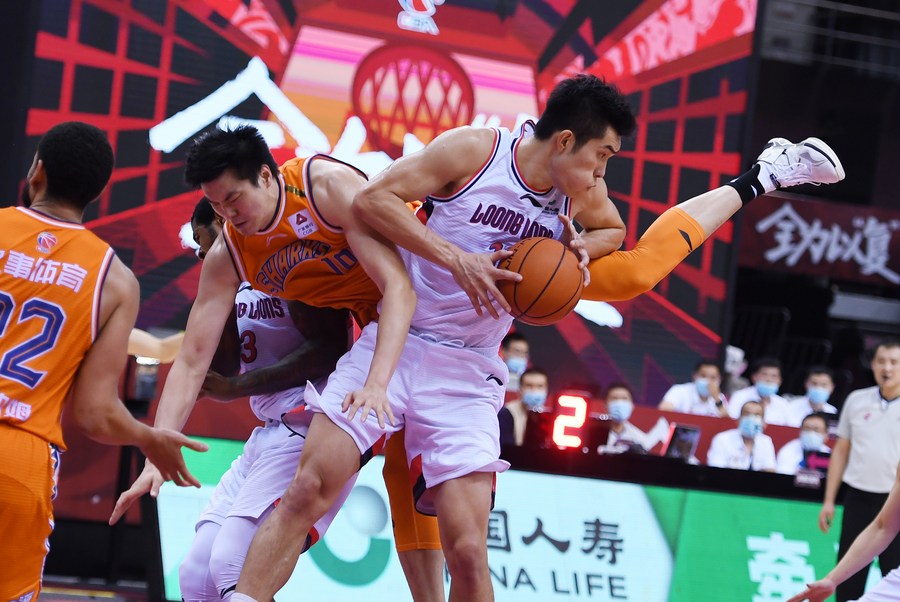
Dong Hanlin (C) of Shanghai vies with Guo Kai (R) of Guangzhou during a match between Guangzhou Loong Lions and Shanghai Sharks at the 2019-2020 Chinese Basketball Association (CBA) league in Qingdao, east China's Shandong Province, July 4, 2020. (Xinhua/Li Ziheng)
For the first time, East Asia will have its very own club-to-club regional basketball competition. The East Asia Super League (EASL), scheduled for October 2021, will feature club teams from China, the Philippines, Japan and South Korea, with teams playing each other in a home-and-away format.
By sportswriter Tobie Taljaard
BEIJING, July 7 (Xinhua) -- For the first time, East Asia will have its very own club-to-club regional basketball competition. The East Asia Super League (EASL), scheduled for October 2021, will feature club teams from China, the Philippines, Japan and South Korea, with teams playing each other in a home-and-away format to ultimately decide a winner at a Final Four event that will rotate between the participating nations.
According to EASL CEO Matt Beyer, a regional tournament of this nature is long overdue, with an unprecedented number of basketball thirsty fans craving a higher level of club competition.
"East Asia, between the geographies that we cover, has over two billion people and people get so excited about the national team competitions, but there really hasn't been that club-to-club model, and this type of rivalry within the region - both from an entertainment perspective, and to have a collective platform to raise up East Asian talent on a global level - is what we aspire to," said Beyer of the thinking that lead to the conception of the league.

Dino Radoncic (L) of Montengro competes during the group O match between Montenegro and Japan at the 2019 FIBA World Cup in Dongguan, south China's Guangdong province, Sept. 9, 2019. (Xinhua/Zhu Zheng)
The league's proposed start date of October 2021 sees it land bang in the middle of a four-year period in which three of the world's biggest basketball competitions will take place in the region. Following China's hosting of the 2019 FIBA Basketball World Cup, Japan will host the delayed Tokyo Olympics in 2021, where basketball Olympic medals are highly coveted, and then the Philippines, Japan and Indonesia will jointly host the 2023 World Cup.
The league aims to build off the success of the Terrific 12 tournament, launched in 2017 as the Terrific 8, which was a condensed version of what the final product will look like. The six-day long event featured three teams from each of the four participating leagues. The first rendition drew 21 million viewers, with the 2019 tournament showing the rapid rise of the event, garnering a mammoth 117 million viewers. Unfortunately, the 2020 tournament, scheduled to be held in Macao in September, was canceled earlier this month due to travel restrictions caused by the COVID-19 pandemic.
Despite the cancellation, and the myriad challenges posed by the world's current lockdown, the management team has been able to adapt and pivot effectively. Beyer noted that the current global landscape "led to us to going really hard at digital content, a decision we made in early March. As face-to-face interactions were limited, fans were hungry for content, even if it wasn't live games."

Kiefer Isaac Ravena (R) of the Philippines passes the ball during the gold medal match of men's basketball between the Philippines and Thailand at the Southeast Asian Games 2019 in Pasay City, the Philippines, Dec. 10, 2019. (Xinhua/Rouelle Umali)
This sentiment was echoed by Chief Commercial Officer Mark Fischer. "In terms of the COVID situation, but also a longer-term trend, all media, including sports media, is accelerating the move toward digital and social media. A lot of younger people hardly watch TV anymore, whereas obviously live games are very much consumed in all sorts of forms of media, a lot of the ancillary programming and things around the game, which is what we're really focused on now. It has been a good direction for us to focus on pivoting towards, despite the other unfortunate circumstances of the COVID situation."
Fischer, with his vast marketing and commercial experience as the former head of the NBA in China and former Managing Director of UFC Asia, believes the fact that the EASL is a smaller organization has helped it to adapt to COVID-19 related challenges. "One of the advantages of the EASL being a relatively young and not fully established organization is that we have the nimbleness and ability to adapt quickly to our surroundings. Because of COVID, and the media landscape changing so quickly in recent years, [we view this] as an advantage for bringing our own brand to consumers and our partners brands to consumers. We have a lot of flexibility because we're not as big a brand as other sports markets."

Ra Guna (R) of South Korea goes up for a basket during the group M match between South Korea and Cote d'Ivoire at the 2019 FIBA World Cup in Guangzhou, south China's Guangdong Province, Sept. 8, 2019. (Xinhua/He Changshan)
The inaugural season of the EASL will be an eight team competition played over a six month period with the top two teams from each of the four nations qualifying. By 2023 the league will expand to 16 teams meaning the top four teams from the respective leagues will be represented in the competition. Each season's Final Four tournament will be hosted by one of the four nations, with the venue rotating between the countries every four years. ■



